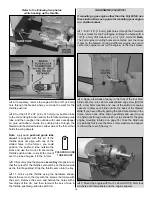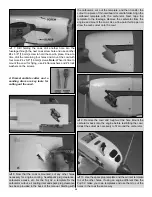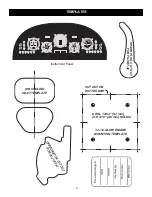
❏
1. Fuelproof all areas exposed to fuel or exhaust residue
such as the wing saddle area, the wing dowels, etc.
❏
2. Check the C.G. according to the measurements
provided in the manual.
❏
3. Be certain the battery and receiver are securely
mounted. Simply stuffing them into place with foam
rubber is not sufficient.
❏
4. Extend your receiver antenna into the antenna tube
inside the fuselage.
❏
5. Balance your model
laterally as explained in
the instructions.
❏
6. Use threadlocking compound to secure critical
fasteners such as the set screws on the wheel
collars, screws that hold the carburetor arm (if
applicable), screw-lock pushrod connectors, etc.
❏
7. Add a drop of oil to the axles so the wheels will
turn freely.
❏
8. Make sure all hinges are securely glued in place.
❏
9. Reinforce holes for wood screws with thin CA where
appropriate (servo mounting screws, cowl mounting
screws, etc.).
❏
10. Confirm that all controls operate in the correct direction
and the throws are set up according to the manual.
❏
11. Make sure there are silicone retainers on all the
clevises and that all servo arms are secured to the
servos with the screws included with your radio.
❏
12. Secure connections between servo wires and
Y-connectors or servo extensions, and the
connection between your battery pack and the on/off
switch with vinyl tape, heat shrink tubing or special
clips suitable for that purpose.
❏
13. Make sure the fuel lines are connected and are
not kinked.
❏
14. Balance your propeller (and spare propellers).
❏
15. Tighten the propeller nut and spinner.
❏
16. Place your name, address, AMA number and
telephone number on or inside your model.
❏
17. Cycle your receiver battery pack (if necessary) and
make sure it is fully charged.
❏
18. If you wish to photograph your model, do so before
your first flight.
❏
19. Range check your radio when you get to the flying field.
The Giant Super Sportster ARF is a great-flying model that
flies smoothly and predictably. It does not, however, possess
the self-recovery characteristics of a primary R/C trainer and
should be flown only by experienced R/C pilots.
A fully-cowled engine may run at a higher temperature than
an un-cowled engine. For this reason, the fuel mixture
should be richened so the engine runs at about 200 rpm
below peak speed. By running the engine slightly rich, you
will help prevent dead-stick landings caused by overheating.
Before takeoff, see how the model handles on the ground
and make sure it tracks straight by doing a few practice runs
at low speeds on the runway. Hold “up” elevator to keep the
tail wheel on the ground. If necessary, adjust the tail wheel
so the model will roll straight. Top off the fuel, and then check
all fasteners and control linkages for peace of mind.
The Giant Sportster is an “honest” flier. Takeoff will be routine
straight forward–just remember to hold a bit of up elevator until
she gets up-to-speed to keep the tail on the ground. Get ready
to apply a little right rudder as the model gains speed and lifts
into the air. Be smooth on the controls and make a gentle
climbout to a safe altitude before making the first turn.
Takeoff
CAUTION (THIS APPLIES TO ALL R/C AIRPLANES): If,
while flying, you notice an alarming or unusual sound such
as a low-pitched “buzz,” this may indicate control surface
flutter. Flutter occurs when a control surface (such as an
aileron or elevator) or a flying surface (such as a wing or
stab) rapidly vibrates up and down (thus causing the noise).
In extreme cases, if not detected immediately, flutter can
actually cause the control surface to detach or the flying
surface to fail, thus causing loss of control followed by an
impending crash. The best thing to do when flutter is
detected is to slow the model immediately by reducing
power, then land as soon as safely possible. Identify which
surface fluttered (so the problem may be resolved) by
checking all the servo grommets for deterioration or signs of
vibration. Make certain all pushrod linkages are secure and
free of play. If it fluttered once, under similar circumstances
it will probably flutter again unless the problem is fixed.
Some things which can cause flutter are; Excessive hinge
gap; Not mounting control horns solidly; Poor fit of clevis pin
in horn; Side-play of wire pushrods caused by large bends;
Excessive free play in servo gears; Insecure servo
mounting; and one of the most prevalent causes of flutter;
Flying an over-powered model at excessive speeds.
Fuel Mixture Adjustments
FLYING
During the last few moments of preparation your mind may
be elsewhere anticipating the excitement of the first flight.
Because of this, you may be more likely to overlook certain
checks and procedures that should be performed before the
model is flown. To help avoid this, a check list is provided to
make sure these important areas are not overlooked. Many
are covered in the instruction manual, so where appropriate,
refer to the manual for complete instructions. Be sure to
check the items off as they are completed.
CHECK LIST
29
Содержание Giant Super Sportster
Страница 32: ......


















